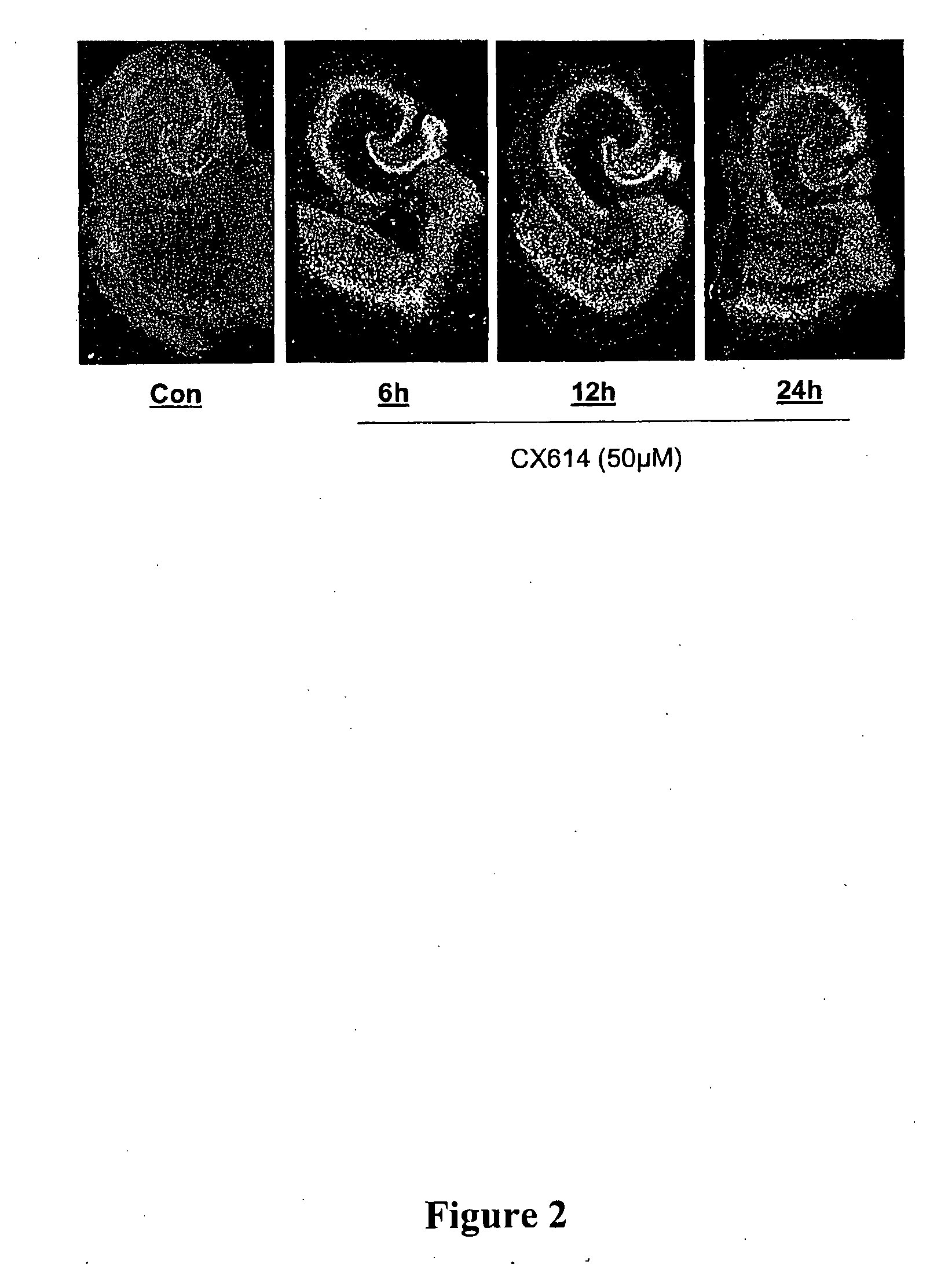Pharmacological modulation of positive ampa receptor modulator effects on neurotrophin expression
a technology of ampa receptor and modulator, which is applied in the direction of biocide, drug composition, muscular disorder, etc., can solve the problems of inducing seizures and/or disrupting normal neuronal function
- Summary
- Abstract
- Description
- Claims
- Application Information
AI Technical Summary
Benefits of technology
Problems solved by technology
Method used
Image
Examples
example 1
General Methods
[0288]1. Tissue Samples
[0289]Cultured hippocampal slices were prepared from rat pups (9 d postnatal) essentially as described by Lauterborn et al. (Lauterborn et al., 2000, J Neurosci 20(1):8-21). Slices were explanted onto Millicel-CM biomembrane inserts (Millipore, Bedford, Mass.; 6 slices / membrane) in a 6-well culture cluster plate (Corning, Cambridge, Mass.) containing sterile media (1 ml / well) consisting of minimum essential media, 30 mM dextrose, 30 mM HEPES, 5 mM Na2HCO3, 3 mM glutamine, 0.5 mM ascorbic acid, 2 mM CaCl2, 2.5 mM MgSO4, 1 mg / l insulin and 20% horse serum (pH 7.2; all reagents from Sigma, St. Louis, Mo.) and maintained for 10-18 d in a humidified incubator at 37° C. in 5% CO2. Media was changed three times / week.
[0290]2. Treatment with AMPAKINES® and mGluR5 Antagonists
[0291]All experiments with the AMPAKINE® (Cortex Pharmaceuticals) and mGluR5 antagonist (gift from FRAXA Research Foundation) began on days 11-12 in culture and were performed essenti...
example 2
AMPAKINES® Increase Hippocampal BDNF mRNA Expression In Vitro: Supra-Threshold CX614 Dose Elevates Levels Through 24 h
[0300]Cultured rat hippocampal slices were treated for 6 h, 12 h or 24 h with the positive AMPA receptor modulator CX614 (50 μM). Control (vehicle-treated) and CX614-treated cultures were processed for the in situ hybridization localization of BDNF mRNA. Photomicrographs (dark-field) show BDNF cRNA labeling (FIG. 2). Hybridization to BDNF mRNA was increased by CX614 treatment throughout the principal hippocampal cell layers, entorhinal cortex, and neocortex by 6 h. With 24 h treatment, levels were beginning to decline although they were still elevated above control densities.
example 3
Treatment with mGluR5 Antagonist MPEP Potentiates CX614-Induced Increases in Hippocampal BDNF mRNA
[0301]Cultured rat hippocampal slices were treated for 3 h with the positive AMPA receptor modulator CX614 (50 μM) with and without the mGluR5 antagonist MPEP (50 μM) as described herein. In situ hybridization analysis of BDNF mRNA in the hippocampal granule cells revealed a 6.5-fold increase in BDNF mRNA in cultures treated with CX614 alone (p<0.001 vs control group). In cultures co-treated with CX614+MPEP, BDNF mRNA levels were increased 10.5-fold above control levels (p<0.001) and were significantly greater than levels in the CX614 alone group (p<0.01). In cultures treated with MPEP alone BDNF mRNA levels in the granule cell layer were unaffected. Similar effects were seen in the pyramidal cell layer of hippocampal region CA1, where CX614+MPEP lead to greater increases (p<0.01) in BDNF mRNA levels than CX614 alone. A representative result is shown in FIG. 3.
PUM
| Property | Measurement | Unit |
|---|---|---|
| Fraction | aaaaa | aaaaa |
Abstract
Description
Claims
Application Information
 Login to View More
Login to View More - R&D
- Intellectual Property
- Life Sciences
- Materials
- Tech Scout
- Unparalleled Data Quality
- Higher Quality Content
- 60% Fewer Hallucinations
Browse by: Latest US Patents, China's latest patents, Technical Efficacy Thesaurus, Application Domain, Technology Topic, Popular Technical Reports.
© 2025 PatSnap. All rights reserved.Legal|Privacy policy|Modern Slavery Act Transparency Statement|Sitemap|About US| Contact US: help@patsnap.com



